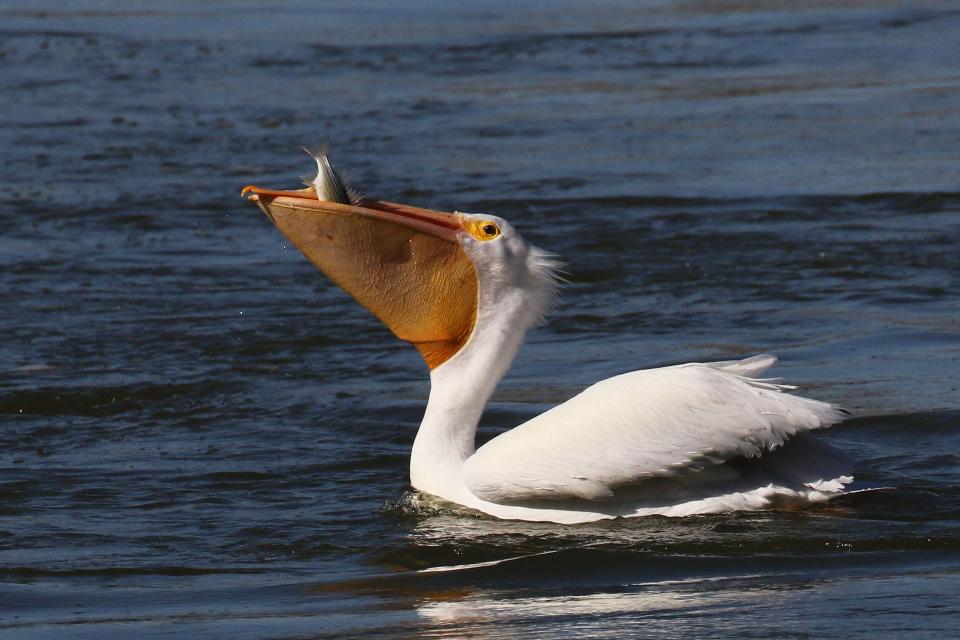It's time to look in the sky (and on water) for massive white pelicans
Numerous reports on social media verify that American white pelicans are on the move through the Tri-State. Reports from Gibson County southward to Henderson County reference flights of 50 or more of these massive birds.
Unusual? Well, yes and no.
They don’t breed here. That happens in fewer than 60 widely scattered, isolated islands through the Dakotas, into central-west Canada, and among scattered sites west of the Rockies.
They don’t overwinter here, either. Well, at least not in the immediate area, but close by. Mostly remaining inland, they loaf away cold weather along rivers and on large lakes featuring sandbars.
Kentucky’s Lake Barkley has long hosted thousands of overwintering white pelicans, packing onto mid-lake islands and bars. Goose Pond FWA near Linton, Indiana, also serves as winter home to over 1,000, attracted to the open spits in marsh waters there.
So when can local residents see dozens to hundreds of massive white birds soaring on nine-foot wingspans, the black wingtips gleaming? Now.
During fall migration, on their leisurely way south, perhaps to Lake Barkley, they pause to loaf and feed wherever shallow waters offer good fishing. Ohio and Wabash river sandbars, when not inundated by floodwaters, often host hundreds during migration. Even local borrow pits along highways can attract their share.
Most folks envision pelicans as massive brown birds gliding in long lines along coastal waters, perhaps viewed from a Florida beachside where the birds demand attention even from the most staid of beachgoers. Those beachside birds, however, differ dramatically from American white pelicans. In spite of their super size, brown pelicans by contrast are small, with a wing span only six-and-a-half feet.

As their name suggests, American white pelicans wear all white except for black wing tips, visible only in flight or at roost when wings are spread. Bulky bodies and stubby tails somehow assume surprising grace when these giants take to the air. Soaring with little effort on those monster wings, they rise to almost-out-of-sight heights.
When low, they flap with steady but startlingly slow wing beats, neck tucked in, those spectacular bills are part of an unmistakable and somewhat prehistoric looking silhouette.
Oh, yes, about those bills. The pelican’s attention grabber isn’t the size of either the brown or white species. It’s that crazy massive bill that makes a pelican a pelican. Used as a scoop, the lower pouch of the bill serves to gather up fish before the bird throws its head back to gulp down the catch.
While brown pelicans inhabit salt water areas and grab fish in a plunge-dive, white pelicans live in fresh water areas and scoop fish from the surface, often working in teams to coral fish for easier catches. Make no mistake, however, about the purpose of that peculiar bill. Pelicans, neither brown nor white, never carry food in those bill pouches. They serve only to scoop before the gulp.
Or put another way, American white pelicans live north while brown pelicans live south.
According to the AllAboutBirds.org website, the oldest known American white pelican was at least 23-1/2 years old and was banded in North Dakota in 1983. I wonder if it flew over the Tri-State. Ironically, the website’s range maps don’t show the magnificent birds wintering here.
For more information about birds and bird habitat, see Sharon Sorenson’s books How Birds Behave, Birds in the Yard Month by Month, and Planting Native to Attract Birds to Your Yard. Follow daily bird activity on Facebook at SharonSorensonBirdLady, or email her at chshsoren@gmail.com.
This article originally appeared on Evansville Courier & Press: Are there pelicans in the Evansville area?

